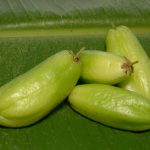
What Is A Prebiotic?
A prebiotic is a selectively fermented ingredient that allows specific changes, both in the composition and/or activity of the gastrointestinal microbiota, that confer benefits upon host well-being and health. Prebiotics are typically non-digestible fibers or carbohydrates such as inulin, fructooligosaccharides (FOS), and galactooligosaccharides (GOS) that pass undigested through the upper gastrointestinal tract and are fermented by beneficial bacteria in the colon. They play a crucial role in supporting the growth and activity of beneficial microorganisms like Lactobacillus and Bifidobacterium species. The microflora in turn produced short chain fatty acids which then have a benefit.
Prebiotics are claimed to have great therapeutic benefits. They are food ingredients that are not digested directly in the gut but are selectively fermented by microorganisms – the so-called probiotics, in the human large intestine and especially the colon. It is estimated we humans have over 100 trillion microorganisms just in our intestines which is over 10 times more than the number of cells that make up our body. It is reasoned there may be up to 1000 different types of indigenous bacteria residing in our guts. The prebiotics cause specific changes both in the composition and/or activity of the gastrointestinal microbiota, thus conferring benefits upon host health.
Consuming prebiotics produces many important physiological benefits in humans (Ferreira et al., 2011) and has been regularly covered in numerous scientific reports (Saad et al., 2013). EFSA have not yet allowed claims to be made on the efficacy of prebiotic-probiotics, but studies have been conducted on a number of health conditions. These include reducing hypercholesterolaemia, reducing diarrhoea and its impact, alleviating chronic conditions like bowel diseases – both irritable and inflammatory, and even preventing food allergies (Buddington, 2009).
The Bifidobacteria and Lactobacillus bacteria which are regularly advertised as beneficial microorganisms or probiotics to us, benefit most from being fed these prebiotics. Prebiotics in the diet helps them grow in preference to less desirable bacteria and pathogens which harm us.
Prebiotics are oligosaccharides, usually fibers which are found in particular types of vegetables such as Jerusalem artichokes, globe artichokes, onions and chicory to name a few. Typical fibres include inulin, the galactooligosaccharides, the fructooligosaccharides and lactulose. One of their likely roles in human health is improving immunity by encouraging the growth of benign microflora in the gastrointestinal tract.
Maillard Browning Products
Prebiotics can also be Maillard reaction products (MRPs). These can be derived from proteins and peptides especially animal and fish sources. As with most prebiotics they also encourage SCFA production. It is claimed they may even be better than some oligosaccharide mixtures. They enhance microbial diversity especially bacteria. Metabolomic profiling indicates they are also effective at improved tryptophan metabolism and improved bile secretion. These are also positive indicators of better modulation of metabolism.
The IFT (Ohr, 2014) surveyed various suppliers of prebiotic ingredients for improving children’s health but applies equally well to adults too. Ingredion Inc. (Westchester, Il. USA) supplies a sugar cane derived prebiotic fibre called NutraFlora® which is produced by their unique proprietary fermentation process and is not GMO (genetically modified organism). The ingredient is mainly composed of short-chain fructooligosaccharides and is also claimed to improve calcium absorption as well as serve as a basic dietary fibre. The short chain length of this fibre apparently makes it less likely to be used by pathogenic bacteria. Other benefits which supplement the prebiotic effects are aimed at the product developer where flavour is concerned -as a fat replacer, flavour enhancer and mouthfeel improver. It appears suitable for liquid and solid formats. Health Canada approved it in 2013 as a dietary fibre source.

The oligofructose-enriched inulin from BENEO Inc. (Morris Plains, N.J. USA) called Orafti® Synergy1 has also been beneficial in a supplemented infant formula. The prebiotic effect was demonstrated in infants up to 4 months old and the fibre tolerated (BENEO, 2013). This study looked at neonates who were fed a formula containing 0.8 g/dL Synergy1 fibre. The control group were fed on a maltodextrin equivalent. Those babies receiving the prebiotic had microflora similar to breast-fed children with softer stools and a better frequency of deposition compared to the control group.
Mental Well-Being
A collaborative research study between the University of Reading, Myota, KU Leuven, and the University of Geneva, demonstrated that a prebiotic supplement can reduce inflammation. The study looked at the effect on metabolic syndrome which is linked with symptoms associated with anxiety, stress and depression (Hall et al., 2024). The participants consumed 10g of prebiotic fibre blend (fructooligosaccharides, inulin, resistant dextrin, resistant maltodextrin, partially hydrolysed guar gum, and guar gum) every day whilst also receiving healthy eating advice for 12 weeks. The control group did not receive any fibre blend but did have the advice.
References
Buddington, R. (2009). Using probiotics and prebiotics to manage the gastrointestinal tract ecosystem. In: Prebiotics and Probiotics Science and Technology. (edited by D. Charalampopoulos & R.A. Rastall). Chester, UK: Springer Science + Business Media. pp. 1–32
Ferreira, C.L., Salminen, S., Grzeskowiak, L. et al. (2011). Terminology concepts of probiotic and prebiotic and their role in human and animal health. Revista de Salud Animal, 33 pp. 137–146.
Ohr, L.M. (2014) Fueling Healthy Kids. Food Technol. 68 (3) pp. 67-71
Saad, N., Delattre, C., Urdaci, M., Schmitter, J.M. & Bressollier, P. (2013). An overview of the last advances in probiotic and prebiotic field. LWT-Food Science and Technology, 50 pp. 1–16.
Revised 6th July, 2014

Leave a Reply